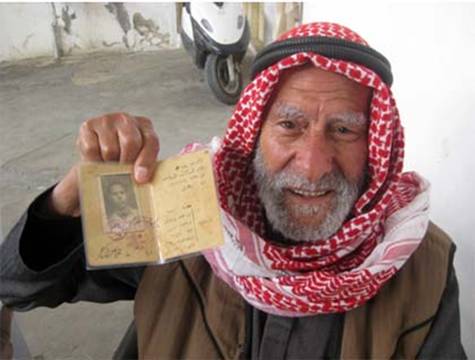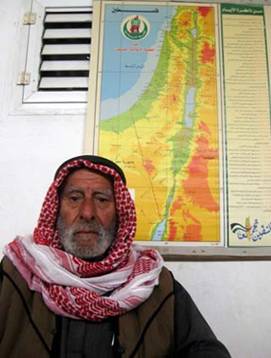www.aljazeerah.info
Nakba Survivors from Isdood, March 2013
Archives
Mission & Name
Conflict Terminology
Editorials
Gaza Holocaust
Gulf War
Isdood
Islam
News
News Photos
Opinion Editorials
US Foreign Policy (Dr. El-Najjar's Articles)
www.aljazeerah.info
Mohammed Tuman Hopes to be Buried in his Home Village, Isdood
By Asem Judeh

Mohammed (85) shows his ID card which was issued by the Municipality of
Isdod in 1947
Mohammed Mohammed Mohammed Tuman (85) was 19 years old when, on 20
December 1948, he and his family were forced to flee their home in Isdod,
now known as Ashdod. Victims of the Nakba (meaning ‘catastrophe’), they
fled along with their entire village of around 8,500 people. For some
time before, inhabitants of other villages had been arriving in Isdood
in their hundreds, bringing with them terrible accounts of the massacres
they had witnessed in places such as Qibya, Basheet, Deir Yassin, and
the Dahmash
Mosque.
No longer safe from the threat of attack by Jewish groups, with the
Egyptian army withdrawing from the area, some 30,000 people set out on
foot and walked for days until they reached relative safety.
Mohammed recounts his memories of the day his family was displaced from
their home: “We were so afraid that we would be killed. Already, 48
villagers had been killed, including my brother, Ahmed, who was killed
by Jewish settlers as he took part in the resistance. 15 more had been
taken prisoner. I kept a note of the name of every person who was killed
or imprisoned. I have that record still. On that day, my father sent me
to speak with the Egyptian commander, to ask him what they would do. I
could not meet him, but I spoke to an Egyptian soldier. I asked him,
“Are you going to stay and defend us, or withdraw?” He answered that he
did not know, but said that he would ask someone. By 4 o’clock that
afternoon, there were no soldiers left. The Jewish groups from the
nearby settlement of Nizanim were well-armed. They had weapons, tanks,
and warplanes. We had nothing. We had to leave.”
The journey south was arduous: “The whole village left, men, women and
children. My family and I were only able to bring a small amount of
flour to make bread and the clothes on our backs. We spent one night in
Hamama, another in Al-Majdal [now known as Ashkelon], and the third
night in Herbiya. We slept under trees, but we were scared of being
attacked. We had no food. Finally, on the fourth day of our journey, we
reached Khan Younis, where some friends of ours lived. Some of my family
had been scattered during the chaos, but eventually we gathered together
in Khan Younis. Our friends had a shelter made of straw that we were
able to live in. After some years, I built a house on the site. In all,
we lived there for fifteen years.”
Mohammed was newly-married, and struggled to start a new life with his
wife, Basima. “I found some agricultural work, but I only earned 10
piasters per day. At the time, that was the price of a kilo of sugar.
Our eldest daughter, Turkiyya, was born in 1949. My wife wasn’t well
enough to breastfeed her so we had to buy milk to feed her from a
neighbour who had a cow. My mother died the following year, when we were
still living in that straw hut. It was a hard and bitter life. Poverty
was widespread. I struggled to make enough money to provide for my
family through agricultural labour and selling some of the produce. My
hands were rough and cracked from using tools to work the land. We lived
in suffering for fifteen years, until UNRWA provided us with a shelter
in Khan Younis refugee camp in 1963, where we live still. The following
year, I began to work for a local family, who had a clothing business.”
Mohammed and his family were forced to flee the refugee camp for a brief
time during the Six-Day War of 1967: “We were very afraid. We moved to
the El-Mawasi area
near the sea and hid under the trees. After seven days, Israeli army
planes dropped leaflets instructing us to go back to the camp, carrying
white flags. We went back. However, I became jobless after the war. Our
standard of living was below zero. My wife’s sister and brother were
living in Lud, in Israel. They sent me a permit to join them and found
me a job as a labourer.”
After 20 years, Mohammed travelled north to the place of his birth: “When I arrived in Lud, I asked if they could bring me to see my village. When I saw Isdood, I was laughing and weeping – laughing because I was seeing my village once more, weeping because it was occupied. It was a mixture of feelings.” The Tuman family had been farmers and landowners, owning 120 dunums of land near the village before they were forcibly displaced. Mohammed had worked the land with his four brothers and their father. “As I wandered around, I found an old key on the ground. I recognised it as the key for starting the engine of the water well, which had since been stolen. I brought the key back with me to Khan Younis.”

Mohammed sitting before a map of Palestine which hangs in his home
Mohammed continued working in Israel until 1978: “At the time it was
very easy for Palestinians to travel to and from Gaza to work in Israel.
When my son, Turkiy, was old enough, he joined me there. Every two weeks
or every month, we came back to Khan Younis for a few days. I couldn’t
stay in Gaza where there was no work. I had a big family – four sons and
five daughters – and I had to provide for them. During that time, I
returned to visit my village, Isdood, many
times. Finally, after 20 years, I returned to Khan Younis and started a
shop.”
It is painful for Mohammed to speak of the more recent Israeli
offensives on the Gaza Strip, ‘Operation Cast Lead’ in 2008/9 and
‘Operation Pillar of Defence’ in November 2012: “All of Gaza was in
danger during those times and we were even more afraid than in previous
wars. Israel has a strong military force with modern weapons, shells,
and fighter jets. There was no safe place in Gaza. And I am an old man
now. I have been in this wheelchair for three years. I can do nothing to
resist the occupation.”
More than 64 years after Mohammed was forced to leave his home, he longs
to return to Isdood. “I still wish I could
return. If I could leave everything, every house that I stayed in since,
everything I have, I would leave it all. I was born there and I am so
attached to that place. The future of my nine children and my 42
grandchildren depends on our return to our home in Palestine. I hope I
will be buried in my home, Isdood.”
It is estimated that at least 700,000 Palestinians were forcibly
displaced from their homes during the Nakba of I948.
Under the operational
definition of the United Nations Relief Works Agency (UNRWA),
Palestinian refugees are people whose normal place of residence was
Palestine between June 1946 and May 1948, who lost both their homes and
means of livelihood as a result of the 1948 Arab-Israeli conflict. The
descendants of the original Palestine refugees are also eligible for
registration. As of 1
January 2012, there were 4,797,723 Palestinian refugees registered with
UNRWA. 1,167,572 of them live in the Gaza Strip.
Under international law, all individuals have a fundamental right to
return to their homes whenever they have become displaced due to reasons
out of their control. The obligation of states to respect the
individual’s right of return is a customary norm of international law.
The right of return for Palestinian refugees specifically is affirmed in
UN General Assembly Resolution 194 of 1948, which “[r]esolves that the
refugees wishing to return to their homes and live at peace with their
neighbours should be permitted to do so at the earliest practicable
date.” The resolution also provides that refugees who choose not to
return, or who suffered damage or loss to their property, should be
compensated by the responsible authorities.
Public Document
**************************************
For more information please call PCHR office in Gaza, Gaza Strip, on
+972 8 2824776 - 2825893
PCHR, 29 Omer El Mukhtar St., El Remal, PO Box 1328 Gaza, Gaza Strip.
E-mail: pchr@pchrgaza.org,
Webpage http://www.pchrgaza.org
|
|
|
|
||
|
||||||


